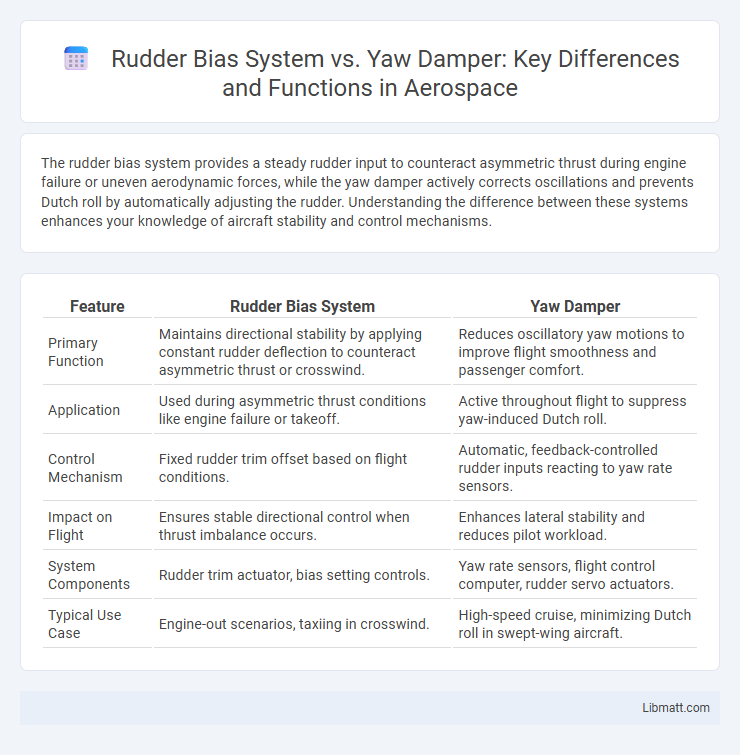The rudder bias system provides a steady rudder input to counteract asymmetric thrust during engine failure or uneven aerodynamic forces, while the yaw damper actively corrects oscillations and prevents Dutch roll by automatically adjusting the rudder. Understanding the difference between these systems enhances your knowledge of aircraft stability and control mechanisms.
Table of Comparison
| Feature | Rudder Bias System | Yaw Damper |
|---|---|---|
| Primary Function | Maintains directional stability by applying constant rudder deflection to counteract asymmetric thrust or crosswind. | Reduces oscillatory yaw motions to improve flight smoothness and passenger comfort. |
| Application | Used during asymmetric thrust conditions like engine failure or takeoff. | Active throughout flight to suppress yaw-induced Dutch roll. |
| Control Mechanism | Fixed rudder trim offset based on flight conditions. | Automatic, feedback-controlled rudder inputs reacting to yaw rate sensors. |
| Impact on Flight | Ensures stable directional control when thrust imbalance occurs. | Enhances lateral stability and reduces pilot workload. |
| System Components | Rudder trim actuator, bias setting controls. | Yaw rate sensors, flight control computer, rudder servo actuators. |
| Typical Use Case | Engine-out scenarios, taxiing in crosswind. | High-speed cruise, minimizing Dutch roll in swept-wing aircraft. |
Introduction to Rudder Bias Systems and Yaw Dampers
Rudder bias systems automatically adjust the rudder to counteract asymmetric thrust, enhancing directional stability during engine failures or crosswind operations in aircraft. Yaw dampers actively detect and correct yaw oscillations by applying small rudder inputs, reducing pilot workload and preventing Dutch roll. Your aircraft's handling and safety improve significantly by integrating these two distinct yet complementary systems.
Core Functions: Rudder Bias vs Yaw Damper
Rudder bias system maintains directional control by applying a fixed rudder input to counteract asymmetric thrust or crosswinds during flight. Yaw damper actively stabilizes the aircraft by damping oscillations and reducing unwanted yaw motions through continuous rudder adjustments. Both systems enhance flight safety, with rudder bias addressing steady-state yaw imbalances and yaw damper managing dynamic yaw stability.
Key Components and Mechanisms
The rudder bias system primarily consists of sensors, actuators, and a control unit that adjusts the rudder position to counteract asymmetric thrust or engine failure. The yaw damper incorporates gyroscopes, accelerometers, and a feedback control system to detect and counteract unwanted yaw oscillations by automatically adjusting the rudder. Both systems rely on precise real-time data inputs and motorized actuators to maintain directional stability but differ in their functional focus: rudder bias addresses sustained lateral forces, while the yaw damper mitigates rapid, short-term yaw movements.
Operational Differences Explained
The rudder bias system automatically adjusts the rudder position to compensate for asymmetric thrust during engine failure, ensuring directional control primarily at low speeds. The yaw damper continuously counters unwanted yaw oscillations caused by turbulence or pilot input, improving aircraft stability and passenger comfort during all phases of flight. Unlike the rudder bias system, which activates under specific conditions, the yaw damper operates continuously to maintain smooth yaw axis control.
Safety and Stability Impacts
The Rudder bias system enhances aircraft safety by automatically adjusting rudder input during asymmetric thrust conditions, reducing pilot workload and preventing unintentional yaw that compromises stability. The Yaw damper actively dampens oscillatory yaw motions, improving flight comfort and stability by mitigating Dutch roll tendencies, especially critical in swept-wing aircraft. Utilizing your aircraft's Rudder bias system alongside a Yaw damper ensures a comprehensive approach to maintaining directional control and overall flight stability.
Common Applications in Aircraft
Rudder bias systems are primarily used in piston-engine aircraft to counteract asymmetrical thrust during engine failure, enhancing directional control on the ground and in the air. Yaw dampers are essential in larger, often turbine-powered aircraft to reduce Dutch roll tendencies and improve passenger comfort by automatically correcting yaw oscillations during flight. Your aircraft's handling characteristics and type of propulsion usually determine whether a rudder bias system or yaw damper is installed for optimal stability.
Advantages of Rudder Bias Systems
Rudder bias systems provide continuous automatic correction of yaw deviations caused by asymmetric thrust, improving aircraft stability without constant pilot input. These systems enhance safety and fuel efficiency by maintaining coordinated flight and reducing drag during engine-out conditions. Your aircraft benefits from smoother handling and reduced pilot workload, particularly in multi-engine operations.
Advantages of Yaw Dampers
Yaw dampers improve aircraft stability by automatically correcting unwanted yaw oscillations, enhancing passenger comfort and reducing pilot workload. They prevent Dutch roll and other yaw-induced instabilities more effectively than traditional rudder bias systems. Your flight experience benefits from smoother handling and increased safety due to the advanced responsiveness of yaw dampers.
Limitations and Challenges
Rudder bias systems face limitations such as reduced effectiveness at very low or high airspeeds due to aerodynamic flow inconsistencies, and they may cause increased rudder pedal forces, potentially leading to pilot fatigue. Yaw dampers, while effective at reducing Dutch roll and enhancing stability, can encounter challenges including system failures or lag in response time, which may result in oscillations or overcorrections. Both systems require rigorous maintenance and calibration to ensure reliability and avoid unintended control inputs that compromise aircraft handling.
Choosing the Right System for Your Aircraft
Choosing the right system for your aircraft depends on operational needs and flight conditions; a rudder bias system actively corrects asymmetric thrust during engine failure, enhancing control during critical moments. In contrast, a yaw damper reduces oscillations and improves passenger comfort during routine flight by automatically controlling yaw motions. Your selection should consider whether priority lies in emergency handling reliability or in-flight stability and smoothness.
Rudder bias system vs Yaw damper Infographic

 libmatt.com
libmatt.com